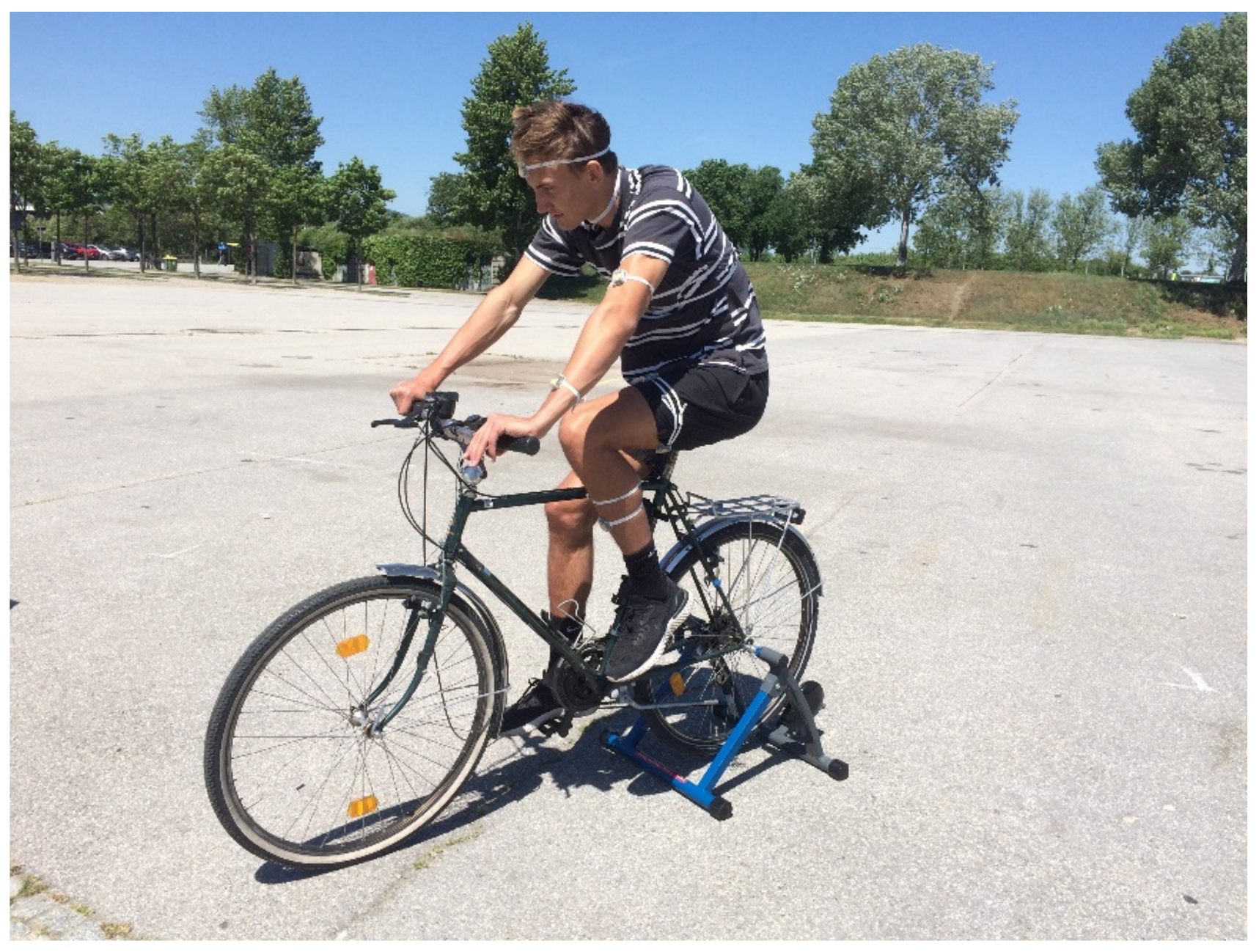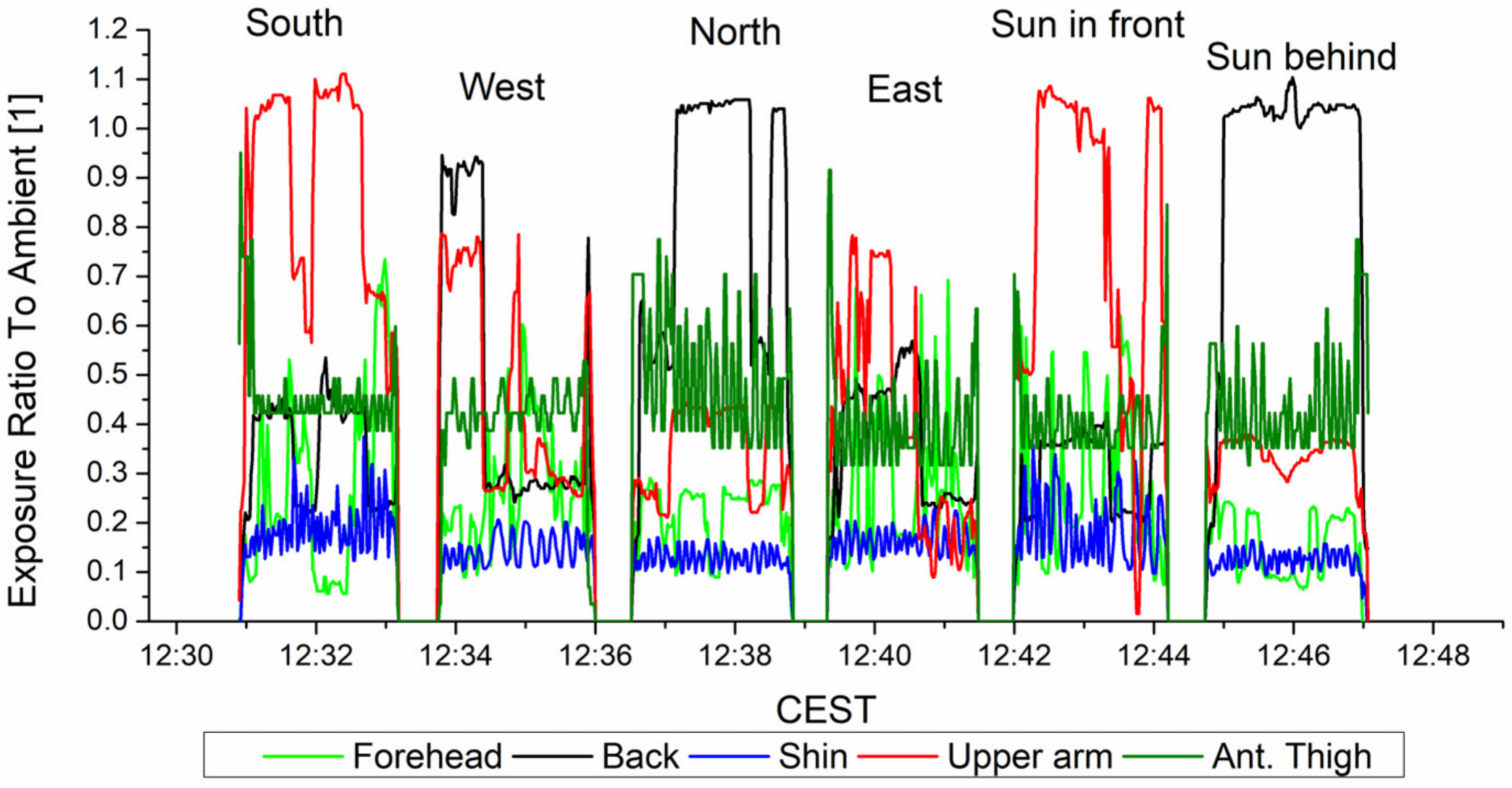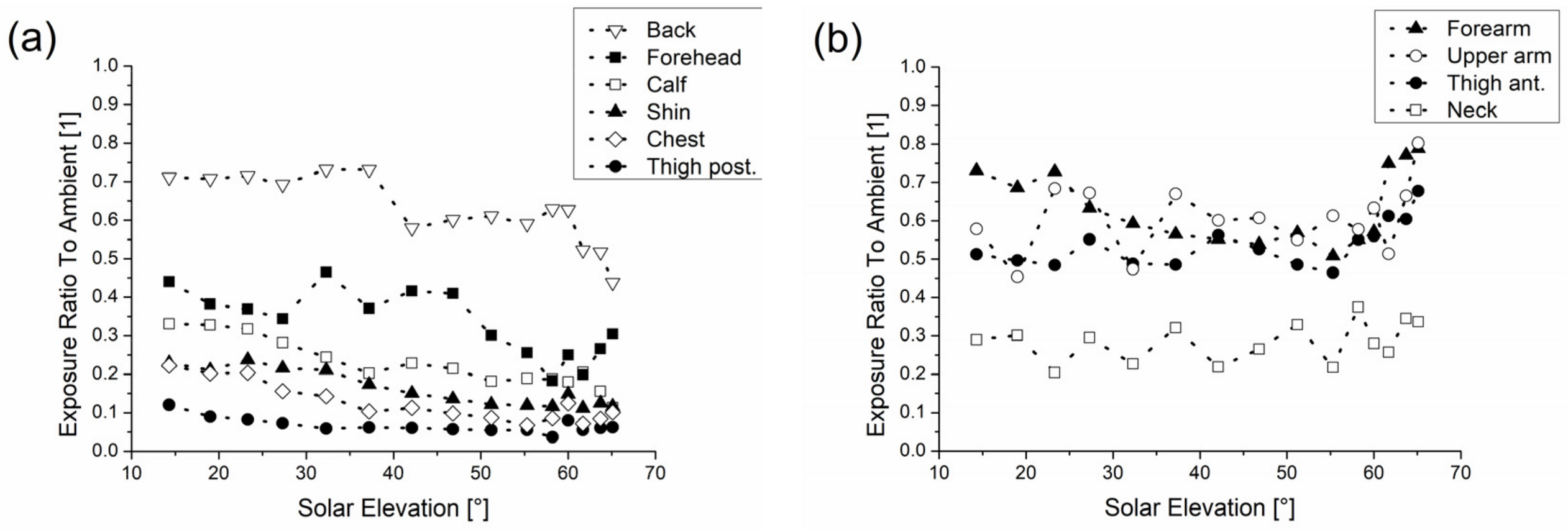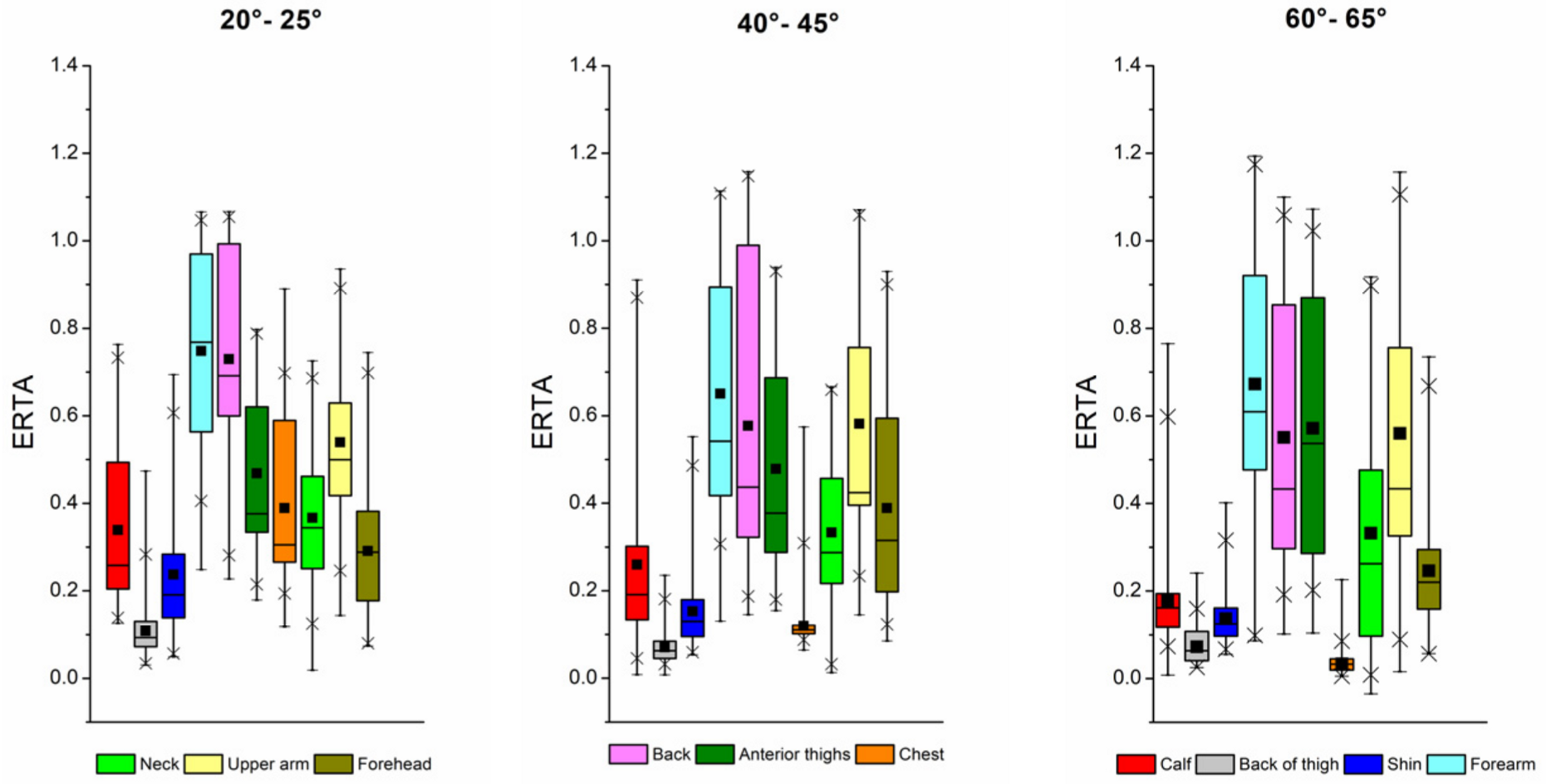UV Exposure during Cycling as a Function of Solar Elevation and Orientation
Abstract
:1. Introduction
2. Material and Methods
2.1. Instrumentation
2.2. Experimental Setup, Location, Time, and Execution of the Measurements
2.3. Analysis of Exposure Ratio to Ambient (ERTA) Data
3. Results
3.1. UV Exposure of Body Sites
3.2. Influence of Solar Elevation
3.3. Influence of Bicycle Orientation
4. Discussion and Conclusions
Author Contributions
Funding
Institutional Review Board Statement
Informed Consent Statement
Data Availability Statement
Conflicts of Interest
References
- Bauer, C.J.S. Beschreibung der v. Drais’schen Fahr-Maschine und Einiger Daran Versuchten Verbesserungen; Steinische Buchhandlung, Nürnberg, Germany, 1817; Westhafen Verlag: Frankfurt am Main, Germany, 2016. [Google Scholar]
- Lessing, H.-E.; Hadland, T. Bicycle Design—An Illustrated History; The MIT Press: Cambridge, MA, USA, 2014. [Google Scholar]
- Lessing, H.-E. Das Fahrrad—Eine Kulturgeschichte; Klett-Cotta: Stuttgart, Germany, 2017. [Google Scholar]
- Statista. Quelle. Available online: https://de.statista.com/ (accessed on 25 January 2024).
- Schmalwieser, A.W.; Schmalwieser, S.S. Exposed Body Surface Area—A determinate for UV Radiant Energy in Human UV Exposure studies. Photochem. Photobiol. 2023, 99, 1057–1071. [Google Scholar] [CrossRef] [PubMed]
- Galloway, S.D.R.; Maughan, R.J. Effects of ambient temperature on the capacity to perform prolonged cycle exercise in man. Med. Sci. Sports Exerc. 1997, 29, 1240–1249. [Google Scholar] [CrossRef] [PubMed]
- Schmalwieser, A.W. Possibilities to estimate the personal UV radiation exposure from ambient UV radiation measurements. Photochem. Photobiol. Sci. 2020, 19, 1249–1261. [Google Scholar] [CrossRef] [PubMed]
- Weihs, P. Influence of ground reflectivity and topography on erythemal UV radiation on inclined planes. Int. J. Biometeorol. 2002, 46, 95–104. [Google Scholar] [CrossRef]
- Höppe, P.; Oppenrieder, A.; Erianto, C.; Koepke, P.; Reuder, J.; Seefeldner, M.; Nowak, D. Visualization of UV exposure of the human body based on data from a scanning UV-measuring system. Int. J. Biometeorol. 2004, 49, 18–25. [Google Scholar]
- Vernez, D.; Milon, A.; Francioli, L.; Bulliard, J.-L.; Vuilleumier, L.; Moccozet, L. A numeric model to simulate solar individual ultraviolet exposure. Photochem. Photobiol. 2011, 87, 721–728. [Google Scholar] [CrossRef] [PubMed]
- Seckmeyer, G.; Schrempf, M.M.; Wieczorek, A.; Riechelmann, S.; Graw, K.; Seckmeyer, S.; Zankl, M. A novel method to calculate solar UV exposure relevant to vitamin D production in humans. Photochem. Photobiol. 2013, 89, 974–983. [Google Scholar] [CrossRef]
- Schrempf, M.; Thuns, N.; Lange, K.; Seckmeyer, G. Impact of Orientation on the Vitamin D Weighted Exposure of a Human in an Urban Environment. Int. J. Environ. Res. Public Health 2017, 14, 920. [Google Scholar] [CrossRef]
- Schrempf, M.; Haluza, D.; Simic, S.; Riechelmann, S.; Graw, K.; Seckmeyer, G. Is Multidirectional UV Exposure Responsible for Increasing Melanoma Prevalence with Altitude? A Hypothesis Based on Calculations with a 3D-Human Exposure Model. Int. J. Environ. Res. Public Health 2016, 13, 961. [Google Scholar] [CrossRef]
- Schmalwieser, A.W.; Gröbner, J.; Blumthaler, M.; Klotz, B.; De Backer, H.; Bolsée, D.; Werner, R.; Tomsic, D.; Metelka, L.; Eriksen, P.; et al. UV Index monitoring in Europe. Photochem. Photobiol. Sci. 2017, 16, 1349–1370. [Google Scholar] [CrossRef] [PubMed]
- Lemus-Deschamps, L.; Makin, J.K. Fifty years of changes in UV Index and implications for skin cancer in Australia. Int. J. Biometeorol. 2012, 56, 727–735. [Google Scholar] [CrossRef]
- Gao, W.; Davis, J.M.; Tree, R.; Slusser, J.R.; Schmoldt, D. An Ultraviolet Radiation Monitoring and Research Program for Agriculture. In UV Radiation in Global Climate Change; Gao, W., Slusser, J.R., Schmoldt, D.L., Eds.; Springer: Berlin/Heidelberg, Germany, 2010. [Google Scholar]
- Blumthaler, M. UV Monitoring for Public Health. Int. J. Environ. Res. Public Health 2018, 15, 1723. [Google Scholar] [CrossRef]
- Allinson, S.; Asmuss, M.; Baldermann, C.; Bentzen, J.; Buller, D.; Gerber, N.; Green, A.C.; Greinert, R.; Kimlin, M.; Kunrath, J.; et al. Validity and Use of the UV Index: Report from the UVI Working Group, Schloss Hohenkammer, Germany, 5–7 December 2011. Health Phys. 2012, 103, 301–306. [Google Scholar] [CrossRef] [PubMed]
- Lemus-Deschamps, L.; Rikus, L. The operational Australian ultraviolet index forecast 1997. Meteorol. Appl. 1999, 6, 241–251. [Google Scholar] [CrossRef]
- Kosmopoulos, P.G.; Kazadzis, S.; Schmalwieser, A.W.; Raptis, P.I.; Papachristopoulou, K.; Fountoulakis, I.; Masoom, A.; Bais, A.F.; Bilbao, J.; Blumthaler, M.; et al. Real-time UV index retrieval in Europe using Earth observation-based techniques: System description and quality assessment. Atmos. Meas. Tech. 2021, 14, 5657–5699. [Google Scholar] [CrossRef]
- Moehrle, M.; Heinrich, L.; Schmid, A.; Garbe, C. Extreme UV exposure of professional cyclists. Dermatology 2000, 201, 44–45. [Google Scholar] [CrossRef] [PubMed]
- Kimlin, M.G.; Martinez, N.; Green, A.C.; Whiteman, D.C. Anatomical distribution of solar ultraviolet exposures among cyclists. J. Photochem. Photobiol. B. Biol. 2006, 85, 23–27. [Google Scholar] [CrossRef] [PubMed]
- Serrano, M.-A.; Canada, J.; Moreno, J.C.; Members of the Research Group of Solar Radiation of Valencia. Erythemal ultraviolet exposure of cyclists in Valencia, Spain. Photochem. Photobiol. 2010, 86, 716–721. [Google Scholar] [CrossRef] [PubMed]
- Curtis, J.; Hull, C.; Hadley, M.I. Ultraviolet radiation exposure among recreational and competitive cyclists in Utah. J. Am. Acad. Dermatol. 2012, 66, AB178. [Google Scholar]
- Downs, N.J.; Axelsen, T.; Parisi, A.V.; Schouten, P.W.; Dexter, B.R. Measured UV Exposures of Ironman, Sprint and Olympic-Distance Triathlon Competitors. Atmosphere 2020, 11, 440. [Google Scholar] [CrossRef]
- Schmalwieser, A.W.; Enzi, C.; Wallisch, S.; Holawe, F.; Maier, B.; Weihs, P. UV Exposition During Typical Lifestyle Behavior in an Urban Environment. Photochem. Photobiol. 2010, 86, 711–715. [Google Scholar] [CrossRef]
- Heydenreich, J.; Wulf, H.C. Personal electronic UVR dosimeter measurements: Specific and general uncertainties. Photochem. Photobiol. Sci. 2019, 18, 1461–1470. [Google Scholar] [CrossRef]
- ISO/CIE 17166:2019; Erythema Reference Action Spectrum and Standard Erythema Dose. International Organization for Standardization: Geneva, Switzerland; International Commission on Illumination: Vienna, Austria, 2019.
- Blumthaler, M. Quality assurance and quality control methodologies within the Austrian UV monitoring network. Radiat. Prot. Dosim. 2004, 111, 359–362. [Google Scholar]
- Webb, A.; Gröbner, J.; Blumthaler, M. A Practical Guide to Operating Broadband Instruments Measuring Erythemally Weighted Irradiance; European Cooperation in Science and Technology: Brussels, Belgium; Publications Office: Luxembourg, 2006. [Google Scholar]
- World Health Organisation. Global Solar UV Index: A Practical User Guide; WHO: Geneva, Switzerland, 2002. [Google Scholar]
- Doncel Molinero, D.; Ruiz Paulano, M.; Rivas Ruiz, F.; Blázquez Sánchez, N.; de Gálvez Aranda, M.V.; de Castro Maqueda, G.; de Troya Martín, M. Sun Protection Behaviour and Sunburns in Spanish Cyclists. J Cancer Educ. 2022, 37, 957–964. [Google Scholar] [CrossRef] [PubMed]
- Fernandez-Ruiz, J.; Montero-Vilchez, T.; Buendia-Eisman, A.; Arias-Santiago, S. Knowledge, Behaviour and Attitudes Related to Sun Exposure in Sportspeople: A Systematic Review. Int. J. Environ. Res. Public Health. 2022, 19, 10175. [Google Scholar] [CrossRef] [PubMed]
- BMVIT—Bundesministerium für Verkehr, Innovation und Technologie. Der Radverkehr in Zahlen, 2nd ed.; Federal Ministry of Traffic, Innovation and Technology (BMVIT): Vienna, Austria, 2013. [Google Scholar]
- Jurczok, F.; Gensheimer, T. Fahrradmonitor 2023; Sinus-Institut: Heidelberg, Germany, 2023. [Google Scholar]
- Ning, P.; Zong, H.; Li, L.; Cheng, P.; Schwebel, D.C.; Yang, Y.; Yang, L.; Wu, Y.; Zhao, M.; Hu, G. Effectiveness of a helmet promotion campaign. China Bull. World Health Organ. 2022, 100, 329–336. [Google Scholar] [CrossRef] [PubMed]
- Nurse, V.; Wright, C.Y.; Allen, M.; McKenzie, R.L. Solar ultraviolet radiation exposure of South African marathon runners during competition marathon runs and training sessions: A feasibility study. Photochem. Photobiol. 2015, 91, 971–979. [Google Scholar] [CrossRef]
- Serrano, M.-A.; Canada, J.; Moreno, J.C. Ultraviolet exposure for different outdoor sports in Valencia, Spain. Photodermatol. Photoimmunol. Photomed. 2011, 27, 311–317. [Google Scholar] [CrossRef]
- Holman, C.D.J.; Gibson, I.M.; Stephenson, M.; Armstrong, B.K. Ultraviolet irradiation of human body sites in relation to occupation and outdoor activity: Field studies using personal UVR dosimeters. Clin. Exp. Dermatol. 1983, 8, 269–277. [Google Scholar] [CrossRef]
- Downs, N.J.; Schouten, P.W.; Parisi, A.V.; Turner, J. Measurements of the upper body ultraviolet exposure to golfers:Non-melanoma skin cancer risk, and the potential benefits of exposure to sunlight. Photodermatol. Photoimmunol. Photomed. 2009, 25, 317–324. [Google Scholar] [CrossRef]
- Siani, A.M.; Casale, G.R.; Diémoz, H.; Agnesod, G.; Kimlin, M.G.; Lang, C.A.; Colosimo, A. Personal UV exposure in high albedo alpine sites. Atmos. Chem. Phys. 2008, 8, 3749–3760. [Google Scholar]
- Schmalwieser, A.W.; Siani, A.M. Review on Nonoccupational Personal Solar UV Exposure Measurements. Photochem. Photobiol. 2018, 94, 900–915. [Google Scholar] [CrossRef] [PubMed]
- Diffey, B.L.; Larko, O.; Swanbeck, G. UV-B Doses received during different outdoor activities and UV-B treatment of psoriasis. Br. J. Dermatol. 1982, 106, 33–41. [Google Scholar] [CrossRef] [PubMed]
- Fitzpatrick, T.B. The Validity and Practicality of Sun Reactive Skin Types I through VI. Arch. Dermatol. 1988, 124, 869–871. [Google Scholar] [CrossRef]
- Vanicek, K.; Frei, T.; Litynska, Z.; Schmalwieser, A. UV-Index for the Public; Publication of the European Communities: Brussels, Belgium, 2000. [Google Scholar]









Disclaimer/Publisher’s Note: The statements, opinions and data contained in all publications are solely those of the individual author(s) and contributor(s) and not of MDPI and/or the editor(s). MDPI and/or the editor(s) disclaim responsibility for any injury to people or property resulting from any ideas, methods, instructions or products referred to in the content. |
© 2024 by the authors. Licensee MDPI, Basel, Switzerland. This article is an open access article distributed under the terms and conditions of the Creative Commons Attribution (CC BY) license (https://creativecommons.org/licenses/by/4.0/).
Share and Cite
Weihs, P.; Helletzgruber, S.; Kranewitter, S.; Langer, L.; Lumerding, Z.; Luschin, V.; Schmidt, P.; Heydenreich, J.; Schmalwieser, A.W. UV Exposure during Cycling as a Function of Solar Elevation and Orientation. Atmosphere 2024, 15, 215. https://doi.org/10.3390/atmos15020215
Weihs P, Helletzgruber S, Kranewitter S, Langer L, Lumerding Z, Luschin V, Schmidt P, Heydenreich J, Schmalwieser AW. UV Exposure during Cycling as a Function of Solar Elevation and Orientation. Atmosphere. 2024; 15(2):215. https://doi.org/10.3390/atmos15020215
Chicago/Turabian StyleWeihs, Philipp, Sarah Helletzgruber, Sofie Kranewitter, Lara Langer, Zacharias Lumerding, Viktoria Luschin, Philipp Schmidt, Jakob Heydenreich, and Alois W. Schmalwieser. 2024. "UV Exposure during Cycling as a Function of Solar Elevation and Orientation" Atmosphere 15, no. 2: 215. https://doi.org/10.3390/atmos15020215
APA StyleWeihs, P., Helletzgruber, S., Kranewitter, S., Langer, L., Lumerding, Z., Luschin, V., Schmidt, P., Heydenreich, J., & Schmalwieser, A. W. (2024). UV Exposure during Cycling as a Function of Solar Elevation and Orientation. Atmosphere, 15(2), 215. https://doi.org/10.3390/atmos15020215






